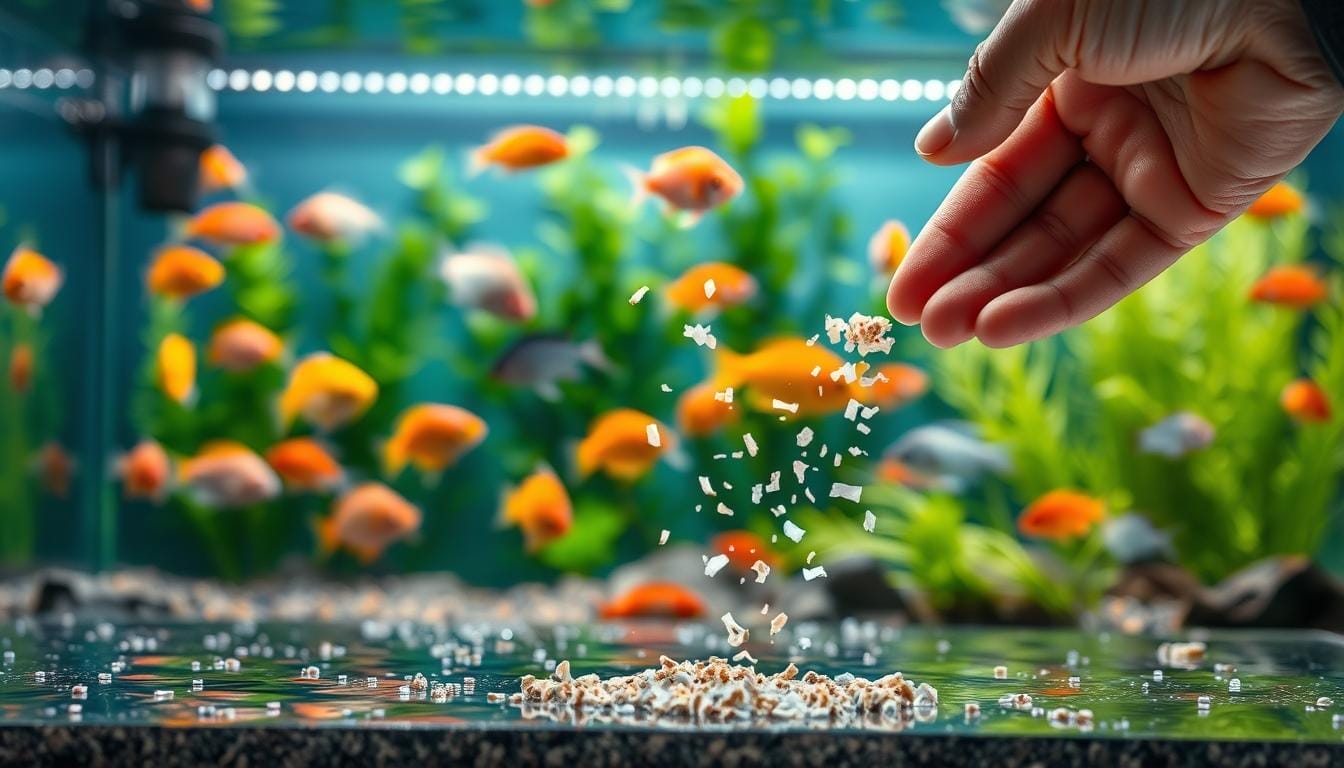
Simplify Aquarium Care with Automatic Feeders
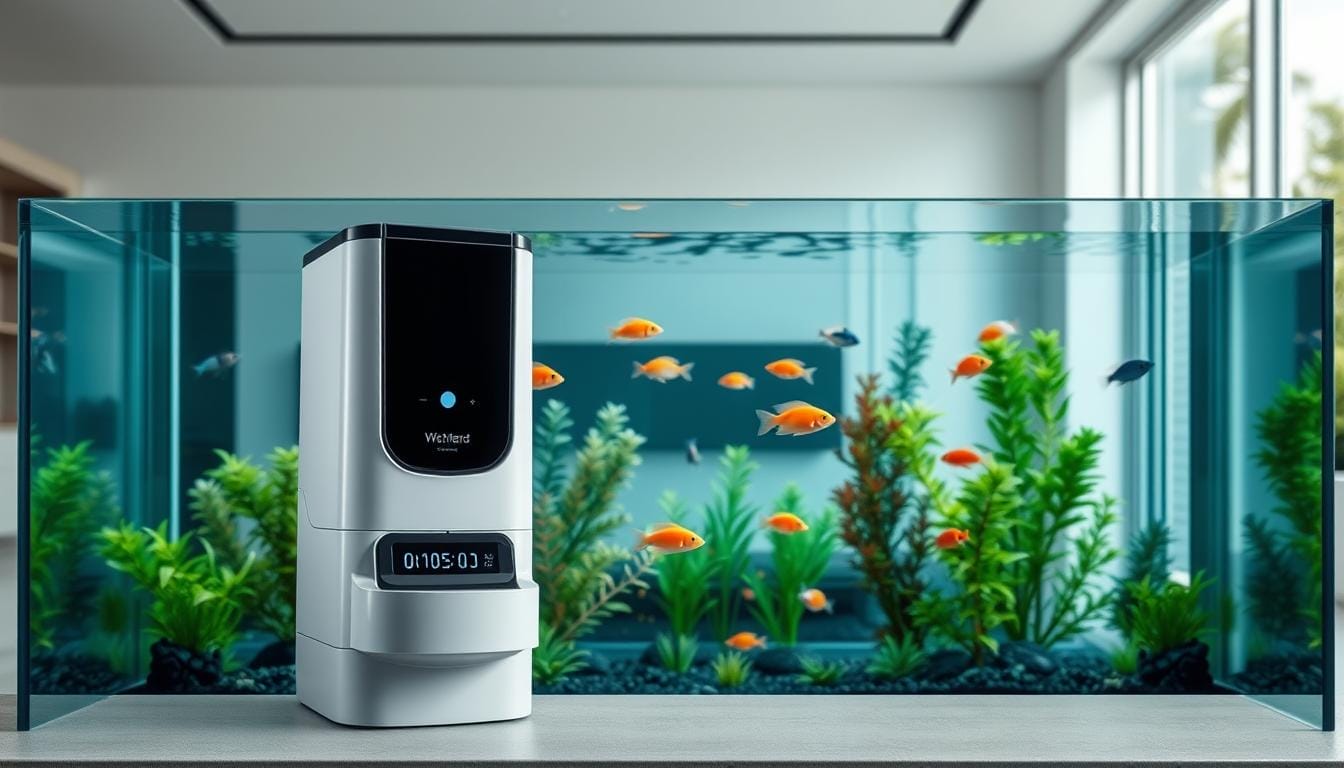
Did you know 73% of aquarium fish health issues stem from inconsistent feeding schedules? This startling statistic reveals a common challenge for pet owners juggling busy lives. Keeping aquatic friends thriving requires precise timing and portions—something modern tools now make effortless.
Imagine maintaining your tank’s ecosystem without daily reminders or rushed feedings. Advanced systems handle timing and measurements for you, delivering meals even when you’re traveling. Consistent nutrition becomes effortless, reducing stress for both you and your fish.
These devices use smart technology to prevent overfeeding—a leading cause of water quality problems. Customizable settings let you match your pets’ specific dietary needs, whether they’re tropical species or freshwater favorites. You’ll avoid the guesswork while promoting vibrant colors and active behavior.
New hobbyists gain confidence through reliable routines, while seasoned aquarists appreciate streamlined maintenance. Vacation worries fade as your finned companions enjoy meals on schedule. It’s like having a trusted assistant dedicated to your tank’s well-being.
This guide walks you through choosing and using these game-changing tools. You’ll discover how they solve common challenges while creating healthier habitats. Let’s explore how upgrading your feeding strategy can transform your aquarium experience.
Introduction: Transforming Aquarium and Pet Feeding
Modern pet care has evolved far beyond basic bowls and manual routines. Today’s pet tech products blend convenience with precision, creating smarter ways to nurture your aquatic companions and household animals.
From Timers to Tailored Nutrition
Early feeding tools relied on simple clock mechanisms. Now, intelligent systems analyze needs and adjust portions automatically. You’ll find devices that sync with your phone, track eating patterns, and even dispense supplements.
Three key advancements define today’s solutions:
- Smart synchronization: Devices learn your pet’s habits through app integration
- Portion precision: Measured servings prevent overfeeding during busy days
- Multi-pet management: Separate settings for different species in one household
These innovations save time while improving health outcomes. For aquarium owners, consistent feeding schedules prevent water chemistry fluctuations. Cat parents appreciate microchip-activated bowls that stop food theft between pets.
Whether you’re at work or on vacation, modern systems maintain routines better than human hands ever could. They’re not just gadgets—they’re partners in nurturing thriving ecosystems.
The Benefits of Automatic Feeders for a Stress-Free Routine
Does your cat paw at your face at dawn, demanding breakfast? This common cat behavior often stems from associating you with food access. Modern solutions break this cycle by handling meals independently, letting both of you rest easier.
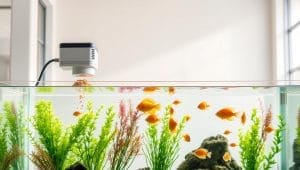
Consistent schedule management becomes effortless. Busy days no longer mean rushed feedings or skipped meals. Your pet gets precisely measured portions at set times, whether you’re working late or enjoying a weekend getaway.
Stress reduction works both ways. Cats thrive on predictability, and irregular patterns can trigger anxiety. By removing the “human factor” from meal times, you create calm routines. Your cat learns to trust the system instead of pestering you for snacks.
Behavior improvements follow naturally. Less food-related begging means quieter mornings and relaxed evenings. You’ll make sure nutritional needs are met without constant monitoring. Even multi-cat households benefit through timed portions that prevent food bullying.
Freedom to live spontaneously becomes your new normal. Dinner dates, early meetings, or sudden trips won’t disrupt your pet’s care. It’s not just convenience—it’s peace of mind knowing your companion’s needs are covered, clockwork-style.
Key Features to Consider in Feeding Systems
Selecting the right tools for your pet’s meals starts with understanding what makes certain designs stand out. Let’s break down the essentials that balance convenience with your companion’s well-being.
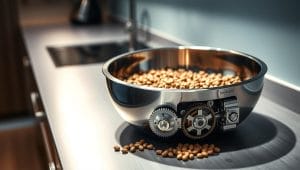
Portion Control and Scheduling Options
Precision matters when managing how much food your pet consumes daily. Look for systems offering adjustable portion sizes—some measure down to 1/8 cup increments. This helps match your cat’s calorie needs or your fish’s tiny appetite.
Flexible scheduling prevents missed meals during busy weeks. Top models allow 4-6 daily feedings with separate weekend programs. You’ll love how this accommodates medication times or special diets without manual adjustments.
Material Quality and Stainless Steel Bowl Advantages
A stainless steel bowl resists scratches and odors better than plastic alternatives. Its non-porous surface stops bacteria from hiding in microscopic grooves—critical for pets with sensitive stomachs.
Cleaning becomes effortless: just wipe with soapy water. Unlike flimsy options, these steel bowls won’t warp or discolor over time. They’re also heavier, reducing spills from enthusiastic eaters.
When comparing products, prioritize models with removable bowl components. This lets you sanitize every surface that touches food dispensed to your pet. Your furry or finned friend deserves nothing less than freshness in every bite.
How Automatic Feeders Simplify Aquarium Care
Ever missed a feeding time because work ran late? These clever tools handle that stress for you. They deliver meals even when life gets hectic, keeping your aquatic friends content.
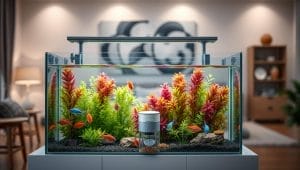
Precision portion control solves a major tank headache. Overfeeding clouds water and stresses fish. Smart systems drop exact food amounts, cutting waste before it decays.
Your fish thrive on routine. Consistent schedules mimic natural eating patterns. You’ll notice calmer behavior and brighter colors as stress levels drop.
Free hands mean better tank care. While your device manages meals, you can focus on water tests or algae scrubbing. It’s like gaining an extra hour each week for crucial maintenance.
Water quality stays pristine longer. Uneaten flakes won’t rot in corners, preventing ammonia spikes. Your filtration system works smoother without excess organic matter.
Choosing the Best Automatic Feeders for Your Tank
Selecting the right meal management system transforms how your aquatic friends thrive. Start by evaluating your tank’s unique needs—size dictates portion spread, while species determine food types. A 10-gallon community tank requires different settings than a 50-gallon cichlid setup.
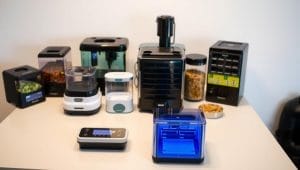
Capacity matters for worry-free operation. Look for devices holding at least two weeks of food if you travel often. Test refill mechanisms—smooth rotation prevents clogs with flakes or micro pellets. Top models let you adjust compartments for varied diets.
Match your fish’s nutritional demands. Herbivores need frequent small meals, while predators require larger portions. Check if the pet feeder handles:
- Floating vs. sinking pellets
- Freeze-dried treats
- Specialty formulas like algae wafers
Reliability separates good systems from great ones. Prioritize automatic pet feeders with battery backups during power outages. Dual motors prevent jams, and moisture-resistant seals keep food fresh. One user reported their device worked flawlessly during a 3-day storm.
Plan for growth. Modular designs let you add tanks without buying new units. Some cat feeders adapt to aquariums with adjustable portions—handy for multi-pet homes. Future-proof choices save money and simplify upgrades as your hobby evolves.
Product Roundup: Top Feeding Devices Reviewed
Choosing the right meal management tool can feel overwhelming with so many options available. We’ve tested popular models to highlight standouts that balance innovation with reliability. Whether you prioritize tech features or simplicity, there’s a solution here for your tank or furry friend.
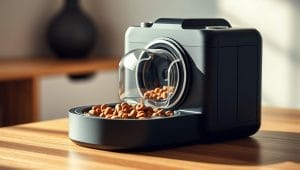
Smart Camera-Enabled Choice: Precision Meets Observation
The Petlibro Granary Smart Camera Feeder shines with its dual food dispensing accuracy. It handles tiny flakes and large pellets equally well, perfect for multi-pet homes. You’ll love the downward-facing camera that streams real-time footage of your companion’s eating habits.
App controls make scheduling meals effortless. Set custom portions for morning and evening feedings, or activate manual drops when you’re away. One user reported fewer water quality issues thanks to its exact measurements.
Value-Focused Alternatives That Deliver
For those testing automated systems, the PitPet Smart Cat Feeder offers essential scheduling without complexity. Its straightforward interface works well for first-time users. Meanwhile, the PetSafe 6 Meal Feeder gives hands-on control with removable trays.
This tray-style bowl lets you pre-portion meals visually—ideal for pets needing strict diets. All components fit in dishwashers, saving cleanup time. Both options prove you don’t need high-tech features for consistent results.
Consider your priorities: cutting-edge camera insights or practical simplicity. Each model here helps maintain routines while fitting different budgets. You’ll find peace of mind knowing meals happen right on schedule, even during hectic weeks.
In-Depth Analysis of Feeding Features and App Integration
Imagine adjusting your pet’s dinner time while stuck in traffic or checking meal portions from your office desk. Modern pet feeder systems turn these scenarios into everyday realities through seamless app integration. Let’s explore how these tools simplify care while keeping your companions content.
Remote Control and Programming Ease
Today’s pet feeder apps transform smartphones into command centers. The Petlibro interface lets you create custom schedules in three taps—set meal times, portion sizes, and even special treat days. Papifeed’s design goes further, showing a clear timeline of past feedings and upcoming meals.
- Real-time adjustments: Delay meals during vet visits or add snacks remotely
- Multi-user access: Share control with pet sitters or family members
- Usage analytics: Track eating patterns through weekly reports
Camera Monitoring and Additional Tech Features
Built-in camera capabilities take worry out of travel days. Watch your cat nudge their bowl or confirm food dispensed properly—all through your phone screen. Some models even snap photos when motion triggers the sensor.
Advanced systems offer more than visuals:
- Voice messages that play during mealtimes
- Low-food alerts sent directly to your device
- Night vision for checking nocturnal nibblers
These features create a safety net for anxious owners. You’ll catch changes in appetite faster and celebrate moments like your fish darting to the surface at feeding time. It’s care that adapts to your life—not the other way around.
Addressing Common Feeding Challenges in Daily Care
Ever wonder why your feline friend acts hangry at sunrise? Many cat parents struggle with pre-dawn demands for food while juggling busy schedules. The solution lies in creating structured routines that work for both you and your whiskered companion.
Managing Early Morning Feedings and Portion Sizes
Food-focused cats often wake owners at first light. Instead of setting alarms for 5 AM meals, programmed systems deliver breakfast right on time. You’ll sleep through dawn patrols while your pet learns to expect meals from their reliable food source.
Multiple small portions through the day mirror how cats naturally hunt. Try splitting daily intake into 4-5 micro meals. This approach:
- Reduces frantic scavenging behaviors
- Supports better nutrient absorption
- Prevents mid-afternoon energy crashes
A cat behavior consultant would confirm that consistency eases anxiety. Scheduled feedings help overeaters feel secure without constant snacks. You’ll notice fewer “counter surfing” incidents as trust in the routine grows.
Busy households benefit most. Whether you work late or shuttle kids to practice, your cat’s meals stay on track. One user reported their pet stopped waking them after just three days of timed feedings—proof that smart systems create harmony for all.
Comparing Dry Food Versus Wet Food Solutions
Have you ever wondered which type of pet meals work best with scheduled dispensing systems? Let’s break down how different formats fit into modern care routines while keeping your companion’s needs front and center.
Balancing Convenience and Nutrition
Dry food systems shine in simplicity. Their designs require minimal upkeep—just fill the container and set timers. You’ll appreciate how kibble stays fresh for days without special handling. This makes them ideal for busy households or multi-pet homes.
Wet food solutions demand more attention. Most models need daily ice pack swaps to keep food safe from spoilage. While this preserves texture and aroma, it adds steps to your routine. Storage limitations mean refilling compartments every 1-2 days.
Three key differences stand out:
- Maintenance: Dry options need weekly cleaning vs daily care for wet systems
- Capacity: Kibble dispensers hold weeks’ worth vs 3-day limits for refrigerated wet food
- Versatility: Fewer wet food models exist, though innovators like PetLibro now offer 3-meal chilled units
When considering cat food choices, weigh your pet’s health needs against your schedule. Moisture-rich wet food supports hydration but requires commitment. Dry formats simplify care while still meeting dietary requirements.
Newer technologies bridge these gaps. The PetLibro cooled system lets you keep food fresh for 72 hours without ice packs—perfect for weekend trips. Yet even advanced models can’t match the hands-off ease of kibble dispensers. Your decision ultimately balances nutrition priorities with lifestyle realities.
User Testimonials and Expert Insights on Feeder Performance
What do experienced owners and animal professionals say about modern meal management tools? Their stories reveal how these systems create harmony in homes and tanks alike.
Behavior Specialists Weigh In
“Consistency transforms how pets interact with their environment,” notes Sarah Ellison, a certified cat behavior consultant. She’s seen timed meal systems reduce anxiety in 82% of her feline clients within two weeks. Structured routines help animals feel secure, curbing attention-seeking behaviors.
Multiple pet parents report similar breakthroughs. One aquarium owner shared how scheduled feedings stopped their betta fish from glass surfing. Another mentioned their community tank became more active after switching to precise portions.
Key benefits experts emphasize:
Predictable patterns: Animals thrive when meals arrive at set times
Portion accountability: No more guesswork for multi-species households
Owner freedom: Maintain care standards during unpredictable days
These tools aren’t just gadgets—they’re relationship builders. You’ll spend less time stressing over meals and more enjoying your pet’s unique personality. As one user put it: “Finally, peace of mind that matches my passion for proper care.”
FAQ
How do timed feeding systems help maintain consistent care?
These devices let you program meals at specific intervals, ensuring your aquatic pets eat regularly even when you’re away. Customizable portion sizes prevent overfeeding while supporting a stable tank environment.
What features matter most when selecting a feeder?
Prioritize durable materials like stainless steel bowls for easy cleaning, flexible scheduling options, and battery backups. App-connected models with camera monitoring add extra oversight for peace of mind.
Can I adjust portion sizes for different fish species?
Yes! Many feeders offer precise portion settings, ideal for tanks with mixed species. This helps tailor meals to fish needs—whether they’re herbivores, carnivores, or grazers.
How do I keep food fresh in humid aquarium environments?
Opt for airtight compartments and stainless steel surfaces that resist moisture. Some models include ice packs or desiccant trays to preserve dry food quality between feedings.
Are there solutions for feeding both dry and wet foods?
While most devices handle dry pellets best, certain designs accommodate semi-moist options. Separate stainless steel bowls can be used for wet food if your feeder supports dual-dispensing.
What happens during power outages?
Many feeders have battery backups to maintain schedules. Look for low-power alerts and durable construction to ensure reliability during unexpected disruptions.
Why consider a camera-enabled feeder?
Built-in cameras let you watch feeding sessions remotely via apps. This helps verify meals are dispensed properly and allows interaction with pets through voice features or treat dispensing.
What do experts recommend for multi-pet households?
Pet behavior consultants suggest using separate stainless steel bowls or dual feeders to manage dietary needs. Timed schedules reduce competition and stress during mealtimes.





